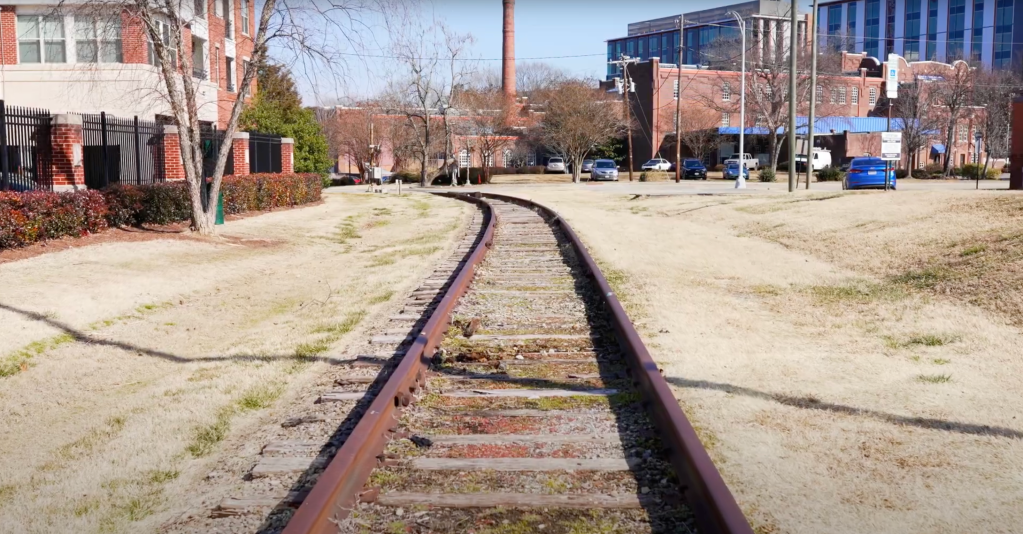More than seven years after the City of Durham bought an inactive railroad corridor with plans of turning it into a trail, the Durham Rail Trail is in its final stages of design.
The Durham City Council heard a presentation during its Thursday work session on the project timeline and amenities, and public art that will be found along the 1.8-mile trail. Construction is set to begin January 2027, with the trail opening to the public June 2028.
The trail will run from “the area around Avondale Drive and Trinity Avenue to just northeast of the Durham Amtrak Station at West Chapel Hill Street, forming a crescent around downtown Durham,” according to the city’s website. The project is projected to cost $45.3 million.
The rail trail is 20 years in the making, something Councilor Carl Rist is mindful of.
“I think it’s pretty clear we were here about a year ago, since then, the timeline’s also been pushed back another year, so we’ve gotta deliver this thing,” Rist said during the work session. “We gotta do it soon.”
Since a schedule for the project was presented to the council last year, the timeline was pushed back six to nine months to further evaluate costs and ensure they remain within the budget, said Henri Prosperi, the city’s project management division manager.
The rail trail is slated to submit 90 percent complete designs to the North Carolina State Department of Transportation in March 2026.
The project will incorporate Durham’s goal of creating renewable energy in city operations through creating a 52 percent increase in households with access to a park by bike or foot, said Iona Thomas, the chief growth and strategy officer for McAdams, a planning, design, and engineering firm.
This is only one item that is designed to attract residents, she said.
Sitting alongside the trail downtown, a proposed Gateway Plaza will include micro retail, a flexible plaza space, native plants, and public art. The plaza would be located between the Durham Amtrak station and the downtown loop, where there is currently a gravel lot. The plaza would serve as a connection between the Durham bus station and downtown, which is slated for several redevelopment projects in coming years. The trail will also connect to the Ellerbe Watershed near Trinity Avenue.

Public art for the rail trail will include the Stagville Memorial Project, a nod to the more than 900 people who were enslaved at the Stagville plantation from 1771 to 1865.
Councilor Chelsea Cook said she has some concerns the rail trail could lead to gentrification or other unintended effects on residents near the route.
“I do want to ensure that as we’re working on this project, we’re thinking about the real impacts on people who actually live in Durham, and whether we’re building a place for those folks or building a place for others we’d like to displace them with,” she said.
Nia Rodgers, a project manager for McAdams who has been involved with the rail trail since 2017, said many low-income residents were already gone by the time her team canvassed the surrounding neighborhoods several years ago.
“The train may have already left the station,” said Rodgers, who helped draft the project’s equitable engagement blueprint and knocked on doors when it was time for community input. “But it doesn’t mean that we can’t change things.”
The rail trail was formerly named the Durham Beltline, which drew inspiration from the Atlanta Beltline, a 22-mile trail. The trail in Georgia’s capital has caused property values to soar and residents to be displaced, generating concerns of gentrification.
Council member Mark-Anthony Middleton said it is never excessive to talk about equity in Durham but the city is “so committed to the equity piece” of the rail trail that the timeline has lagged partially because of community engagement.
“I think the prominent place of Stagville in this project is a direct result of our equitable engagement to make sure that all of the voices and colors and stripes of Durham are prominently, perhaps the most prominent place along this trail… has been left to the descendants of those that were formerly enslaved,” Middleton said. “That’s because we spoke to the community.”
Comment on this story at [email protected].
